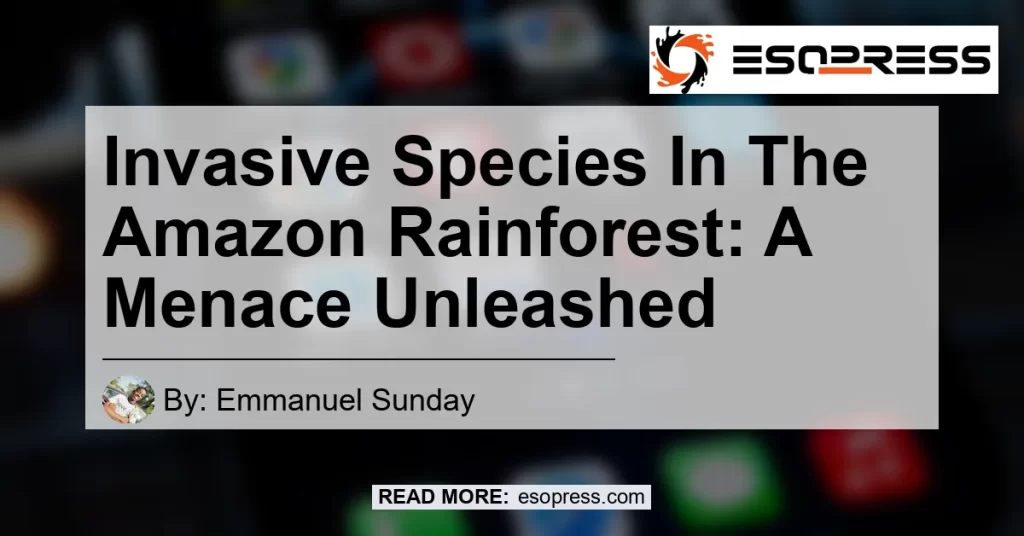

The Amazon rainforest is one of the most diverse and delicate ecosystems on the planet. It is home to countless species of plants and animals that are found nowhere else in the world. Unfortunately, this delicate balance is under threat from the invasion of non-native species. Invasive species in the Amazon rainforest pose a significant risk to the native flora and fauna, leading to ecological imbalances and the potential extinction of endemic species. In this article, we will explore the main invasive species in the Amazon region and discuss the impact they have on this fragile ecosystem.
Contents
The Main Invasive Species in the Amazon Region
Pau-de-lacre (Vismia guianensis)
One of the main invasive species in the Amazon rainforest is the Pau-de-lacre, known scientifically as Vismia guianensis. This plant is native to the Guiana Shield region of South America but has spread rapidly into the Amazon. It is a small tree that grows up to 10 meters in height and produces bright yellow flowers. Pau-de-lacre spreads through its seeds, which are dispersed by birds and other animals. Once established, it can form dense thickets, outcompeting native vegetation and reducing biodiversity.
Another invasive species in the Amazon is the Capim-navalha, scientifically known as Paspalum virgatum. It is a grass species that can reach heights of up to 1.5 meters. Capim-navalha is native to the grasslands of Argentina and Uruguay but has made its way into the Amazon through human activities such as deforestation and agriculture. It forms dense stands and competes with native grasses, reducing habitat quality and disrupting local ecosystems.
The Impact of Invasive Species on the Amazon Rainforest
The presence of invasive species in the Amazon rainforest has far-reaching consequences. These non-native species disrupt natural ecosystems and cause harm to native plants and animals in various ways. Here are some of the impacts of invasive species in the Amazon:
Competition for Resources
Invasive species often have competitive advantages over native species. They can grow and reproduce rapidly, outcompeting native plants for nutrients, water, and sunlight. This competition can lead to a decline in native plant populations, altering the structure and composition of the forest ecosystem.
Habitat Destruction
Invasive plant species like Pau-de-lacre and Capim-navalha can form dense thickets that choke out native vegetation. These thickets can prevent the growth of native trees and shrubs, leading to a loss of habitat for animals that rely on these plants for food and shelter. The destruction of habitat can disrupt food chains and ultimately lead to the decline of species that are dependent on specific ecological niches.
Predation on Native Species
Some invasive species in the Amazon, such as the black rat, prey on native species. Black rats, which have been introduced to the region through human activities, feed on the eggs and young of bird species, endangering their populations. The predation pressure exerted by invasive species can disrupt the delicate balance of predator-prey relationships in the rainforest.
Disease Transmission
Invasive species can also act as carriers of diseases that are harmful to native animals. For example, the chytrid fungus, which is thought to have been introduced to the Americas by the African clawed frog, has decimated amphibian populations in many parts of the Amazon rainforest. The spread of diseases through invasive species can have cascading effects on the entire ecosystem.
Addressing the Invasive Species Problem
The invasion of non-native species in the Amazon rainforest poses a significant challenge for conservation efforts. However, there are measures that can be taken to address this problem and mitigate its impacts. Here are some strategies that can be employed:
Prevention
Preventing the introduction of invasive species is the most effective way to address the problem. This can be done through better regulation of international trade and stricter biosecurity measures at borders. Importing goods and materials that may harbor invasive species should be subject to rigorous inspection to minimize the risk of introducing them into the Amazon rainforest.
Early Detection and Rapid Response
Detecting invasive species early and responding quickly is crucial to prevent their spread and minimize their impact. Regular monitoring and surveillance programs should be implemented to identify the presence of invasive species in the rainforest. Once identified, prompt action should be taken to control and eradicate them before they become established.
Restoration of Native Vegetation
Restoring native vegetation in areas affected by invasive species can help to restore ecological balance and improve habitat quality. This can be achieved through reforestation efforts and the removal of invasive plants. In some cases, biological control methods, such as the introduction of natural predators or diseases specific to the invasive species, may be used to manage their populations.
Education and Awareness
Raising awareness about the impacts of invasive species and the importance of biodiversity conservation is key to addressing the problem. Educational campaigns can be conducted to inform the public, policymakers, and local communities about the risks associated with invasive species and the need for proactive measures to prevent their spread.
Conclusion
Invasive species in the Amazon rainforest pose a serious threat to the delicate balance of this unique ecosystem. The introduction of non-native species through human activities such as deforestation and international trade has the potential to disrupt native habitats, reduce biodiversity, and threaten endemic species. Preventive measures, early detection, habitat restoration, and public awareness are key to managing the invasive species problem in the Amazon. By taking decisive action, we can protect the rich biodiversity of this precious rainforest and ensure its survival for future generations.
Best Recommended Product: Groundhog Repellent Spray
One effective way to combat the spread of invasive species in your own garden or backyard is by using a groundhog repellent spray. Groundhogs, also known as woodchucks, can wreak havoc on your plants and introduce non-native species to your environment. By using a repellent spray specifically designed to deter groundhogs, you can protect your garden and prevent the spread of invasive species.
The best recommended product for this purpose is the “Bonide (BND237) – Repels-All Animal Repellent Concentrate” available on Amazon. This highly effective repellent contains natural ingredients that deter groundhogs and other animals, keeping them away from your garden without causing them harm. Simply mix the concentrate with water and apply it to the affected areas to create a barrier that repels groundhogs and prevents them from inflicting damage.
Click here to check the product on Amazon


By using a groundhog repellent spray, you can protect your garden from invasive species and create a safe and thriving environment for native plants and animals. Don’t let invasive species take over your backyard – take action now and safeguard your green space with the Bonide (BND237) – Repels-All Animal Repellent Concentrate.
Remember, the Amazon rainforest is a precious and fragile ecosystem, and it is our responsibility to protect it from the detrimental impacts of invasive species. Together, we can preserve the biodiversity of this unique habitat for generations to come.






